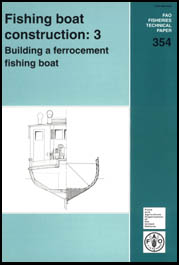

By
Richard O.N. Riley
Hainford, Norwich, Norfolk
United Kingdom
and
Jeremy M.M. Turner
Senior Fishery Industry Officer
Fishing Technology Service
Fishery Industries Division
FAO, Rome
FAO FISHERIES TECHNICAL PAPER
354
Food and Agriculture Organization of the United Nations

Rome, 1995
ISSN 0429-9345
|
The designations employed and the presentation of material in
this publication do not imply the expression of any opinion whatsoever on the
part of the Food and Agriculture Organization of the United Nations concerning
the legal status of any country, territory, city or area or of its authorities,
or concerning the delimitation of its frontiers or boundaries. |
M-41
ISBN 92-5-103764-7
All rights reserved. No part of this publication may be reproduced, stored in a retrieval system, or transmitted in any form or by any means, electronic, mechanical, photocopying or otherwise, without the prior permission of the copyright owner. Applications for such permission, with a statement of the purpose and extent of the reproduction, should be addressed to the Director, Publications Division, Food and Agriculture Organization of the United Nations, Viale delle Terme di Caracalla, 00100 Rome, Italy.
© FAO 1995
1.1 Ferrocement: a material for fishing boats
1.2 What is ferrocement?
2. LOFTING REQUIREMENT AND TECHNIQUE FOR A FERROCEMENT HULL
2.1 Introduction
2.2 Boat plans
2.3 Mould loft floor
2.4 The grid
2.5 Laying off profile and plan view
2.6 Battens, splines and straight edges
2.7 Body plan
2.8 Additional information gathered
2.9 Transom projection
2.10 Patterns - general
2.11 Camber pattern
3. SITE, WORKSHOP, EQUIPMENT, TOOLS AND LAUNCHING SYSTEMS
3.1 Site
3.2 Workshop structure and layout
3.3 Services
3.4 Equipment
3.5 Tools (loose)
3.6 Launching systems
4. MATERIALS USED IN FERROCEMENT CONSTRUCTION
4.1 Frame rods
4.2 Rod reinforcement
4.3 Mesh reinforcement
4.4 Staples and lacing wire
4.5 Welding rods
4.6 Cement
4.7 Sand
4.8 Admixtures
4.9 Jointing compounds
4.10 Water
5. MATERIAL TESTING AND PRACTICE
5.1 Compression test
5.2 Slump test
5.3 Taking a sample of cement
5.4 Sand testing and practice
5.5 Water:cement ratio (weight)
5.6 Cement:sand ratio (weight)
5.7 Additional tests
6. CONSTRUCTION OF A FERROCEMENT HULL
6.1 Introduction
6.2 Design
6.3 Supporting the structure
6.4 Keel, backbone and stem construction
6.5 Frame, web and floor construction
6.6 Setting up the frames
6.7 Sheer or gunwale
6.8 Knuckle line
6.9 Fairing in the frames
6.10 Beamshelf construction
6.11 The hull reinforcement
6.12 Liner tubes for stern gear and rudder gear
6.13 Plummer block supports
6.14 Engine bed construction
6.15 Bilge keels
6.16 Requirements for fitting a nozzle
6.17 Preparatory work prior to casting
6.18 Casting procedure
6.19 Curing the hull
6.20 Water testing and finishing off
7. REPAIRS AND JOINTS IN FERROCEMENT
7.1 Temporary/minor repairs
7.2 Major repairs
7.3 Joints in hull or deck
8. PREPARING AND PAINTING A FERROCEMENT HULL
9. REQUIREMENTS SPECIFIC TO FERROCEMENT BOAT CONSTRUCTION AND FERROCEMENT/TIMBER FITTING OUT
9.1 Requirements specific to ferrocement boat construction
9.2 Ferrocement/timber fitting out
10. RULES FOR THE CONSTRUCTION AND CLASSIFICATION OF FERROCEMENT VESSELS
1. DRAWINGS OF 12.8 M FERROCEMENT STERN TRAWLER
2. OUTLINE SPECIFICATION OF 12.8 M FERROCEMENT TRAWLER
3. 12.8 M FERROCEMENT TRAWLER COSTS3.1 Cost of jigs and patterns
3.2 Hull costs (including engine beds, floors, webs, bilge keels, rudder and stern tube liners)
3.3 Fitting out costs
3.4 Analysis of costs4. COLLATING LABOUR AND MATERIAL DATA FOR FERROCEMENT BOAT CONSTRUCTION
MATERIAL USED IN THE DOCUMENT AND SUPPLIED BY ORGANIZATIONS LISTED IN THE ACKNOWLEDGEMENTS